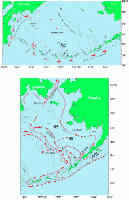
U.S. Dept. of Commerce / NOAA / OAR / PMEL / Publications
Recommendations from an International Symposium on Pollock [Aron and Balsiger, 1989] provide the research objectives for FOCI: determine stock structure in the Bering Sea and its relationship to physical features, and understand recruitment processes in the eastern Bering Sea. Both of these have direct implication to management of the vast resources that exist in U.S., Russian and international waters. To attain the first objective, field and modeling studies have investigated circulation throughout the deep basin. Another component seeks to establish genetic "finger-prints" to evaluate stock structure. In addressing the second objective, we are investigating differences between survival of eggs and larvae over the deep waters to that over the adjacent shelf. A newly established component is comparing habitats of juvenile animals around the Pribilof Islands.
Many of the characteristics of walleye pollock early life history are common
to all populations of the species. In the Bering Sea, however, both the population
structure and early life history pattern are much more complex than in the Gulf
of Alaska. Genetic characteristics [Mulligan
et al., 1992] and length-at-age and fecundity relationships [Hinckley,
1987] suggest several spawning stocks exist. The importance of pollock in
the ecosystem [e.g.,
Springer, 1992], as well as the relationships and interchange among
stocks are largely unknown. Spawning begins earlier in the year in some parts
of the Bering Sea than it does in Shelikof Strait and apparently different groups
of fish spawn at different times and places. We began our efforts focusing on
the population that spawns in February over the southeastern slope, and supported
a substantial fishery in the late 1980's. Here we found indications that some
of the eggs and larvae were much deeper in the water column
Prior to FOCI research many schematics existed of circulation in the Bering
Sea, and wind stress was considered to provide the primary forcing [Hughes
et al., 1974]. Results from FOCI have refined our knowledge of circulation
(Figure 2) and meteorological forcing over the basin from both observations
[Stabeno
and Reed, 1994] and model studies [Overland
et al., 1994]. A cyclonic gyre dominates circulation over the basin,
with a western boundary current (Kamchatka Current) along the Asian side of
the basin [Reed
et al., 1993]. This gyre is mainly an extension of the Alaskan Stream,
and the majority of volume transport enters through Near Strait
Figure 2. Upper Panel: A schematic of the general circulation over the basin of the Bering Sea as derived from ongoing FOCI research (after Stabeno and Reed [1994]). Lower Panel: A schematic of circulation over the eastern shelf based on previous results [Schumacher and Kinder, 1983], together with more recent satellite-tracked buoy [Stabeno and Reed, 1994] and moored current observations [Schumacher and Reed, 1992]. ACC is the Alaska Coastal Current, which enters through Unimak Pass, and W represents regions with weak or statistically insignificant mean flow.
The flux
Return to previous section or go to next section